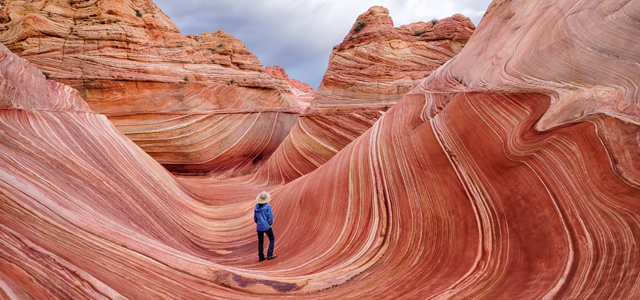Geology: A Very Short Introduction, Jan Zalasiewicz, Oxford University Press.
A Wilder Time: Notes from a Geologist at the Edge of the Greenland Ice, William Glassley, Bellevue Literary Press.
The discipline of geology is sometimes seen as the study of boring rock specimens by specialists, but these two books might help erode such prejudices. Jan Zalasiewicz contends that the whole Earth and its long history is geology’s subject. It is amazing what can be read from the rocks: past lives, lost continents, changed climates, unimaginable forces operating over inconceivable timescales. William Glassley’s personal account of exploring Greenland’s landscape notes the challenges geology makes intellectually and even spiritually.
When the nineteenth century Romantics pondered Europe’s grand alpine landscapes they lauded them as the Sublime, prompting awe at the vastness of time and space that dwarfs individual human existence. From a Christian perspective, I feel that beyond the aesthetic pleasures of the landscape and historical interests involved, thinking about the forces beneath our feet adds another layer to the wonder expressed by the psalmists who marvelled the natural world. It may also help us, like Job, to keep our own lives in the perspective of cosmic time.
Geology: A Very Short History is a factual account of what happens within and at the surface of the Earth and a history of geology as a scientific discipline in Europe. It recounts how, regarding the latter, fossils and layered rocks gave tantalizing glimpses into formerly unimagined worlds, and created head-scratching over how to reconcile the geological record with the Genesis account of Creation and Flood. Of course reconciliation was possible, but not without some controversy.
Zalasiewicz mentions luminaries such as James Hutton, who noticed folded rock strata and wondered what they might mean. Fossil hunters who wowed the Victorian public, not only with their reconstructions of real monsters, but also with their dizzying re-imaginings of the scale of geological time, were also mentioned. Zalasiewicz also features two of my favourites, Alfred Wegener, who postulated continental drift, explaining fossil distribution and mountain building, though in his lifetime he was ridiculed for the idea. Along with Marie Tharp, whose persistent mapping of the sea floor proved Wegener’s thesis, also proving her arrogant and myopic male colleagues wrong in the process.
Of course geology still evolves with newly unearthed knowledge. In recent years, the discovery of fossils of primitive life in the Flinders Ranges of South Australia added a new section to the geological timescale, pushing back the date of the first multicellular life. The dating of rocks using zircon crystals refines the history. Just one of the informational gems on display here is that diamonds formed very early in Earth’s history contain minerals formed in subduction zones (the places where continents meet), giving us a glimpse of the beginning of tectonics.
Geology is not just a science of the deep past. Geology is linked to climate: volcanoes, continents impeding or allowing ocean current flow, mountain building – all these redirect weather. And the geological tinkering of humans – not just fossil fuel burning, but also the use of fertilisers and concrete, and the redirecting of water flows – affects the climate, as we are well aware. Geology is also a study of the future.
Greenland is one of the places where human activity is having a noticeable effect. Scientists travel to Greenland to record this in detail, but, conversely, it is also a place where such a huge tract of wilderness with a seeming indifference to the human can reconfigure our attitude. In A Wilder Time, William Glassley travels there to investigate the remnants of a mountain range. In the process he and his colleagues discover the site of two continents colliding and grinding together, closing what was once a large sea. That’s the scientific side. The other side of the book is Glassley’s descriptions of his sense of being overwhelmed by wonderment. He can’t help but sound a little mystical as he describes disorientation then revelation.
Human beings, he says, inhabit a small niche in the world, in regards to our size and what we can perceive visually and aurally. We are not attuned to the microscopic, oceanic or aerial, or even too much of the plant and animal worlds around us. This is brought home to him when he crouches down in the tundra to observe the wildlife at ground level and is barraged by floral scents not detectable when he is standing. Science can illuminate these other worlds but the spiritual experience of visiting these worlds is something else again, he says. It is a challenge to put such experiences into words, but one of the pleasures of the book is Glassley’s lyrical attempts to do so.
Greenland is often described as a barren area of rock and ice, but there is richness. Tundra which is a world in itself of lichens and mosses, and rocks alive with colour and movement, which Glassley likens to an art gallery. He finds sheets of marble, created from limestone buried deep in the Earth, and giant crystals.
Aside from the beauty, wilderness also asks questions of us regarding its value and our responsibilities. We are caretakers of Creation, and not just in utilitarian terms. Places of wilderness are worth conserving because they are places where the human has not intruded. Like geology, and like religion, wilderness reminds us that our human world is only a limited part of a much wider one, a perspective that can only help the human one.
Nick Mattiske blogs on books at coburgreviewofbooks.wordpress.com














